While the kids are gathering sweet treats this Halloween, get a celestial scare with these frightful deep-sky sights.
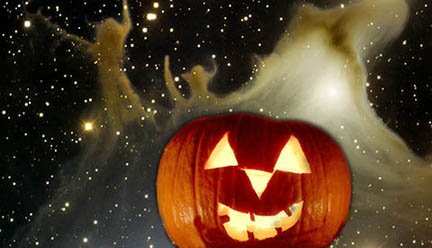
T.A. Rector / University of Alaska Anchorage, H. Schweiker / WIYN and NOAO / AURA / NSF; Pumpkin: Bob King
How fortunate we are to have moonless skies during the week leading up to Halloween. The night the kids walk door to door under their witches' hats and pirate masks, the thinnest sliver of Moon will appear for less than than an hour in the west at sundown. A phantom. There and gone before you know it. Saturn and Venus linger longer, a pair of planetary eyes in conjunction just 3° apart on the 29th, widening to 3.5° on the 31st, and low in the southwestern sky.
I like darkness at Halloween because it feels right. Early sunsets and a swift end to twilight bring the night out in a hurry. With insects and birds now departed, the landscape is hushed. Add a pinch of foreboding and dash of fright, and a night alone at the telescope may send shivers up your spine. Or is that the falling temperature? To help you attain a state of delighted delirium, I offer several scary nebulae for your viewing pleasure.
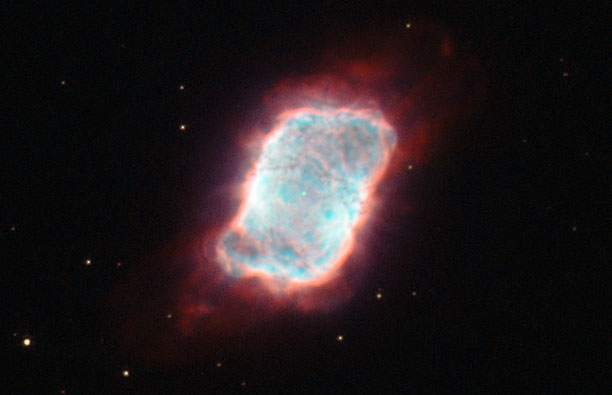
NASA / ESA / Hubble Space Telescope
They have ghoulish names like the Skull Nebula, Phantom Streak, and the Ghost of the Moon and encompass everything from bright to dark to planetary nebulae. The photos help to suggest their namesakes, though a little imagination doesn't hurt either. May the next clear night bring you face to face with nature's frightful beauty.
All the observations below were made with a 15-inch reflecting telescope unless otherwise noted:
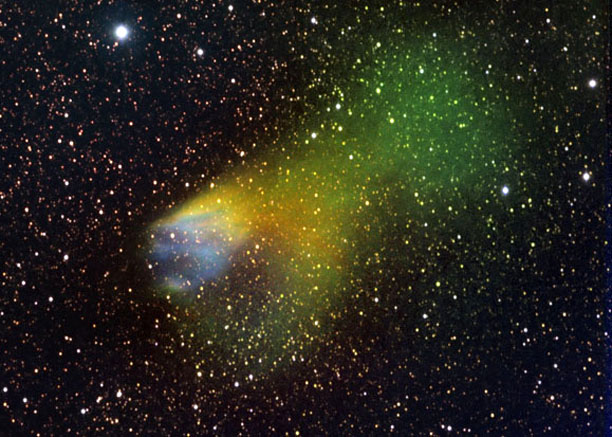
Sharplesscatalog.com
- Death Eater Nebula in Serpens (Sharpless 2-68, planetary nebula) in Serpens located at 18h 25m, +00° 51.5′. The telescopic view doesn't come close to its frightening photographic appearance. Nothing visible without an O III filter, but with the O III at 64x I glimpsed a large, diffuse, roundish haze about 8′ across, the south end of which appeared slightly brighter. Magnitude 13.1, Size: 430″ × 330″.
- The Phantom Streak (NGC 6741, planetary nebula) in Aquila at 19h 02.5m, –00° 27′. A very tiny but relatively bright nebula that really pops when blinked with a UHC or O III filter. The Hubble Space Telescope photograph (above) reveals a fascinating shape and texture, but the best I could do was discern the lozenge-like shape. Even that required a magnification in excess of 357× and patient perusal. Magnitude 11, Size: 6″.
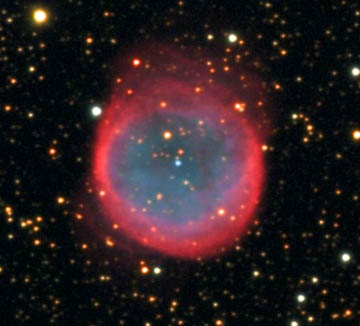
Jim Misti
- Ghost of the Moon Nebula (NGC 6781, planetary nebula) in Aquila at 19h 18.5m, +06° 32′. Hands down, the visually scariest-looking nebula of the bunch. A faint, ghostly bubble at 64× without a filter. With the O III in place, the nebula becomes much more distinct with a crisp circumference but still retains the delicate look of ectoplasm afloat in the celestial void.The combination of 142×, a UHC filter and averted vision exposed a big, dark hole in center of the bubble, while the southern half of the ring appeared thicker and brighter than the northern.
- Barnard's "E for Evil" Nebula (Barnard 142–143 dark nebulae pair) in Aquila at 19h 40m, +10° 57′, 3° northwest of Altair. Two neighboring dark nebulae with high opacity are evil enough to make a good show even in 10×50 binoculars.Together they spell the letter "E." In the happy light of day, they're known as "Barnard's E" after the American astronomer E. E. Barnard, but at Halloween-time, I'm going with "E for Evil." All in good fun, of course. Short-focus telescopes with wide fields of view show the pair in striking contrast to the rich, starry backdrop. Sizes: Barnard 142, 30′ × 30′; Barnard 143, 30′ × 15′.
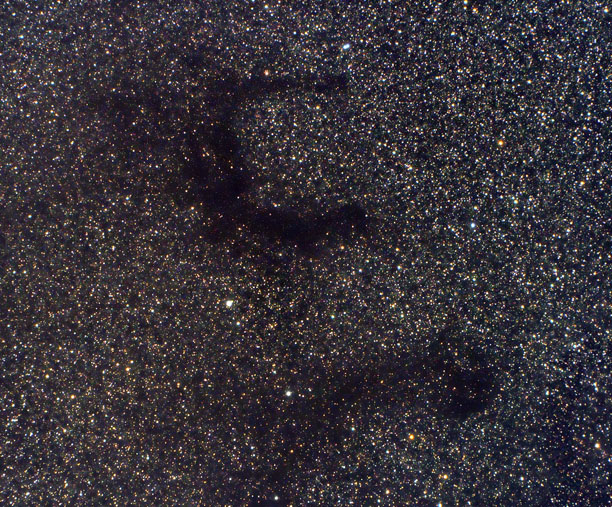
Hunter Wilson
- Ghost Nebula (Sharpless 2-136 = VdB 141, reflection nebula) in Cepheus at 21h 16.5m, +68° 16′. Spectacularly spooky in deep photographs, I see an obvious round smudge of nebulosity surrounding an ~11 magnitude star. Easily visible at 64× but better at 142×. I picked up a hint of an extension to the south, maybe a bit of mottled texture but no ghosts! Size: brightest part ~4′.
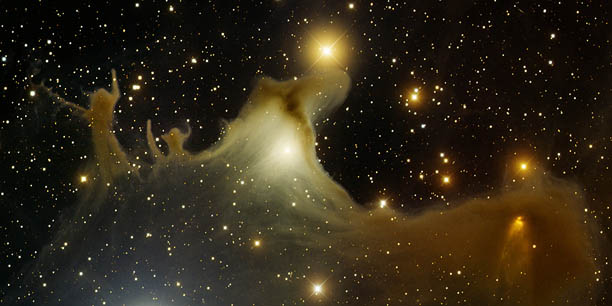
T.A. Rector / University of Alaska Anchorage, H. Schweiker / WIYN and NOAO / AURA / NSF
- Skull Nebula (NGC 246, planetary nebula) in Cetus at 0h 47m, –11° 52.3′. Large, rather faint object with four magnitude +10–12 field stars visible across its face. Oval shape with a fairly distinct outline except along southeast side (chin area), which is considerably fainter. An O III filter does a nice job increasing contrast and showing the dark patchy interior and sharply-defined skull top. Eerie-looking object due in part to the several overlapping field stars. Magnitude 8, Size: 3.8′
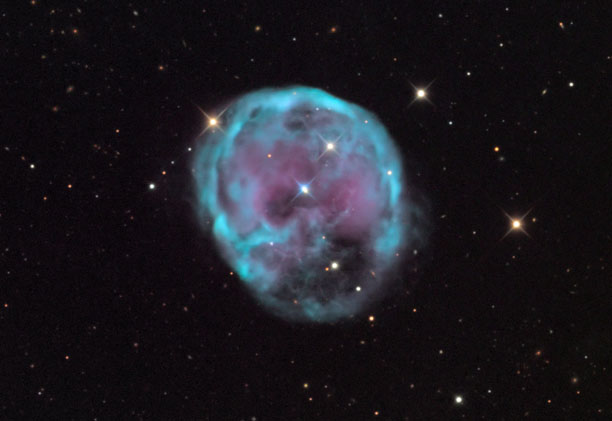
Adam Block / Mount Lemmon SkyCenter / University of Arizona
- Witch Head Nebula (IC 2118, reflection nebula) in Eridanus at 5h 02m, –07° 54′. A large, mottled, north-south elongated haze at 64× more than 2° in length. Faint, but not difficult from a dark sky in both 10-inch and 15-inch telescopes. It helps to sweep back and forth quickly from side to side — from nebula to dark sky and back — to see its borders more clearly. Magnitude +13, Size: 3° × 1°.
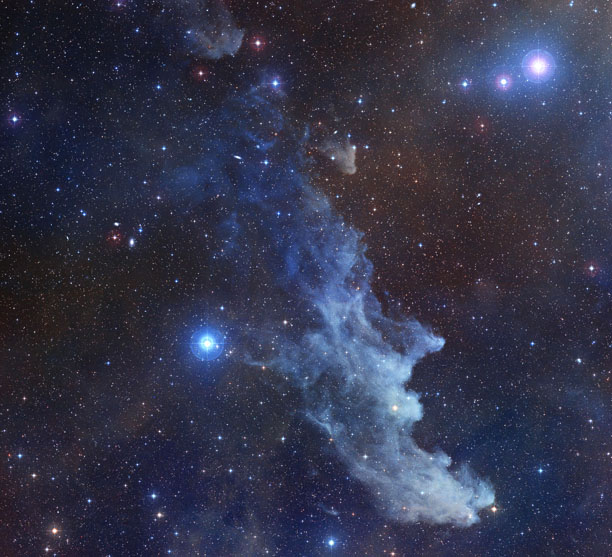
NASA / STScI Digitized Sky Survey / Noel Carboni
- Specter of Death Nebula (NGC 1999, reflection nebula) in Orion at 5h 36.5m, –06° 43.3′, Located only 1° south-southeast of the Orion Nebula. Very nice dense ball with a distinct dark hole visible at 100× and higher magnifications. The hole appears round and slightly off-center and pops in and out of view while switching from direct to averted vision. Magnitude +9.5, Size: 1.5′
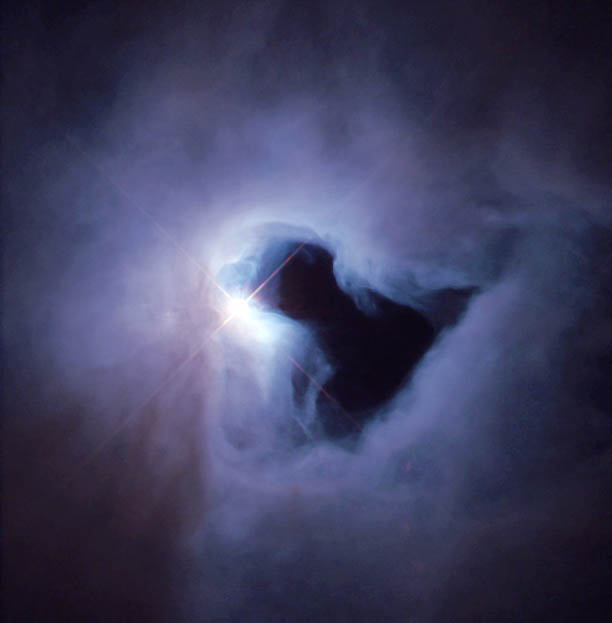
NASA / ESA and the Hubble Heritage Team (STScI)
- The Demon Star in Perseus (3h 08m, +40° 57′). No survey of deep-sky frights would be complete without mentioning Algol, a star long suspected of suspicious behavior. Algol is an eclipsing variable that dims from magnitude 2.1 to 3.4 every 2.9 days asa larger, fainter companion orbits in front of the smaller, brighter primary star. Below are dates and times when Algol will be at minimum. The star remains at minimum for about 2 hours centered on the times, taking a few hours to fade to minimum and the same amount of time return to maximum brightness.
Algol minima (EDT):
Oct. 31 at 5:53 a.m.
Nov. 3 at 2:42 a.m.
Nov. 5 at 11:31 p.m.
Nov. 8 at 8:19 p.m. CST
You'll find our featured objects with one exception plotted on the following charts in the Uranometria 2000.0 Deep Sky Atlas (All Sky Edition). They also appear in the two-volume earlier edition of the atlas:
Sharpless 2-68 (P30.6+6.2): Chart 106
NGC 6741: Chart 105
NGC 6781 and Barnard 142, 143: Chart 85
Sharpless 2-136: Reiner Vogel's Sharpless Observing Atlas
NGC 246: Chart 140
IC 2118: Chart 137
NGC 1999: Chart 136
 4
4








Comments
Curt
October 30, 2016 at 12:52 am
NGC 1999 has always reminded me of a black pawn chess piece.
You must be logged in to post a comment.
Bob KingPost Author
October 30, 2016 at 12:08 pm
Curt - exactly! Especially in the Hubble image.
You must be logged in to post a comment.
Bob
October 31, 2016 at 12:27 am
Great collection of spooky nebulae images.
You must be logged in to post a comment.
Bob KingPost Author
October 31, 2016 at 12:43 am
Happy Halloween, BP!
You must be logged in to post a comment.
You must be logged in to post a comment.